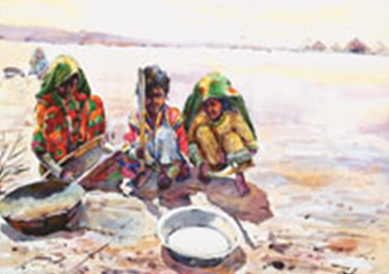Hinterland Art: Pakistan
This is a collection of articles archived for the excellence of their content. Readers will be able to edit existing articles and post new articles directly |
Hinterland Art
By Salwat Ali
The academic and artistic acumen of an art institution or university department can be gauged by the art curriculum taught to the students, the strength of its teaching faculty and the work of the alumnae who are the true representatives of the establishment.
The art wing of the University of Sindh, Jamshoro came into being as early as the 1970’s and the initial appointments of prominent artists like A R Nagori and Musarat Mirza as teaching faculty, and later as heads of department, spoke volumes about its educational standing. Unfortunately the art unit, after all these years, has yet to realise its true potential. Students graduating from the University of Sindh have yet to distinguish themselves as mainstream artists with a flair for innovation and experiment.
In the last decade or so random entries of genre painters from the hinterland, in group shows or very rare solo exhibitions, is perhaps the only record we have of artists from this art institution. Their thrust on rural landscape and depiction of village culture typical to the region brings some exclusiveness to their paintings but the distinction is minimal.
A two artist exhibition by Mohan Das and Shahid Iqbal at Citi Art Gallery, Karachi recently was the latest showing of hinterland art. The two artists completed their Masters in fine Arts from the University of Sindh in 2002 and went on to participate in group shows together. Their current display is by far the largest they have had so far and it centralises on a picturesque narration of the Tharri landscape and its inhabitants.
Specific to the gypsy culture of the nomadic tribes that roam the vast expanse of the Ngarparkar and Cholistan deserts, the paintings, realistic renditions that they were, capitalised on the quaint and the picturesque, rather than depiction of the harsh and impoverished existence that is the lot of these people. Painting life in an open arid terrain with a focus on the domestic environment of women and children, rendered in vibrant palette of rainbow colours endowed the works with an idyllic rustic charm. This pleasant, scenic, chocolate box portrayal appeals to the average viewer. The allure of folklore and unchanged traditions in the face of modernity is there but does it address the real predicament of Thar? Are these just quaint pictures or do we read a message in the tranquil serenity of the people. Resigned to their fate they accept adversity as a way of life.
Shahid Iqbal and Mohan Das are artists with potential, they have deft painting skills but there are some lapses in their picture perfect figures. A thorough study of anatomy and a series of life drawing lessons help in working the figure with confidence. It is important to understand the body structure hidden beneath the costume and the drapery of voluminous folds. Likewise drawing of hands and feet also indicate artistic skill and observation and both artists need to improve and refine their approach in this regard.
A realistic rendering of sand swept locales washed in the blaze and glare of the noon day sun, a glowing sunset or the tumultuous monsoonal skies ably painted by the artists establishes the essential atmosphere of the place. Women and children, dressed in the traditional gaily coloured gaghras, cooking, washing, collecting firewood or fetching water are well placed as the real protagonists in the paintings. Mohan Das captures the female form up-close as single figure studies while Shahid Iqbal prefers to paint them in groups at work and leisure. Colorful, simplistic and very literal the works remind us of a folk life we seldom speculate upon beyond its apparent beauty.





